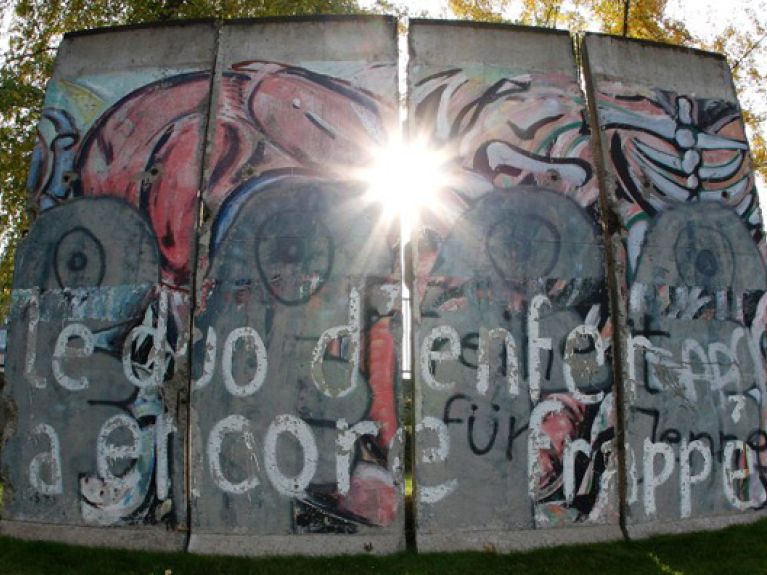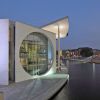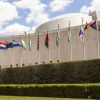A symbol travels around the world
Segments of the former Berlin Wall are now found on all continents – and make history tangible.

It is rather astonishing how much love and affection is now shown towards this once despised structure. In any event, the section of the Berlin Wall that stands in Simi Valley, California, is very well looked after. From its present position you have a magnificent view of the Pacific. The blocks have received a special coating of paint to protect them against the wind and the weather. A plinth also keeps the damp at bay. Nothing is to harm the monument with butterfly graffiti and faded lettering that might spell out the word “Free”.
Of course, this bold declaration of freedom is completely unnecessary because this piece of the Wall speaks for itself. Appropriate images immediately spring to mind: people dancing on the top of the Wall, falling into one another’s arms, unable to grasp what is happening. These scenes moved the world. During the night of 9 November 1989 the Wall became a universal symbol for the triumph of democracy.
In reunified Germany, however, initially many people no longer wanted to see it. The Wall was the symbol for separated families and destroyed dreams, a stone reminder of the time of the SED regime. It was an open wound that went right through the heart of Berlin. Even if the damage had been done, at least no scars were to be left behind.
Internationally, on the other hand, the Wall became a cult object. According to the chronicle of events by the Federal Foundation for the Reappraisal of the SED Dictatorship in its book The Berlin Wall in the World, offers to buy sections of the border installations were received as early as 10 November 1989. This represented the beginning of a debate about how to treat the German-German past that has continued until the present – and the starting signal for the Wall’s journey around the world.
Today, large and small Wall segments can be found on all continents. The Federal Foundation located segments at 146 locations around the globe. In the USA alone there are more metres of the Wall than there are in Berlin. Symbols of the victory over communism seem to have become most popular where people were most jubilant about its failure. Everywhere, whether in Washington, Yokohama or Buenos Aires, the Wall represents the triumph over dictatorship and the end of oppression.
Many of the new “Wall owners” were artists. They recognised the symbolic power of the structure very early on – and its potential for carrying additional meaning. Ludwik Wasecki, for example, erected an entire monumental landscape on his land in a village near Wroclow. Sections of Wall alternate with his own installations. However, they do not enjoy a great deal of attention. The same applies to the four Wall segments that Indonesian artist Teguh Ostenrik had shipped to Jakarta. However, he was unable to realise his planned project and the enormous blocks of concrete still stand in his front garden.
Far more onlookers are attracted by the Wall segments that have found their way to museums – for example, in front of the Imperial War Museum in London or at the Olympic Museum in Lausanne. Public parks or squares are also popular locations. These meeting places sometimes contain references to Germany in their names. The section of the Wall that went to the French capital under the auspices of the twinning agreement between Berlin and Paris stands in the Esplanade du 9 novembre 1989.
In Latin America and many countries of Central and Eastern Europe, these Wall monuments connect with local experiences of dictatorship. Where would a piece of the Wall be more fitting than at the shipyard in Gdansk where Solidarność was born or in Chile, where people freed themselves of the Pinochet regime after almost 20 years? In the Chilean capital Santiago, in 1992, remembrance of the GDR past and its ongoing judicial resolution came together in a rather surprising way. Within view of the Wall memorial in front of his official residence, Germany’s Ambassador Wiegand Pabsch described the unfortunate fact that the former GDR head of state, Erich Honecker, had found refuge in the Chilean Embassy in Moscow.
The Wall segments around the world are many things: personal memories, educational and cultural objects, political symbols. Several merely serve commercial interests. Some firms believed these historic objects would make a good impression in their lobbies. When Daimler-Benz presented Wall segments to business partners, Bill Gates also received one. And a restaurant in Portland unashamedly promotes itself as having “the best lobsters on the East Coast” and a piece of the Berlin Wall. How the owner came by this special interior decoration is unclear.
The sought-after relics often took long and convoluted routes into the world. Immediately after the fall of the Wall, very few people in Germany sought to obtain parts of the border. Those who warned against this included Willy Brandt, former Federal Chancellor and Ruling Mayor of West Berlin. The people in charge during the transitional period, on the other hand, saw the offers from abroad as an opportunity to obtain hard currency. The hope was that they would be able to partially offset the high costs of dismantling the border. A specialist foreign-trade firm was commissioned with the marketing. Auctions in Berlin and Monaco further boosted sales.
Only later was it realised that places are needed for remembrance, that it is difficult to imagine how a neighbouring city district once belonged to a different country. This is now still only really tangible in Berlin in Bernauer Strasse, where an impressive memorial space has been created in recent years.
Incidentally, while the Wall went out into the world, things also came in the other direction: Japan made Germany a present of a thousand cherry trees after reunification and they were planted along the former border strip. ▪

